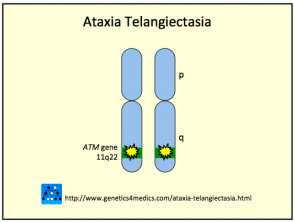What is ataxia?telangiectasia?
Ataxia-telangiectasia is a rare inherited multisystem disorder characterized by:
- Ataxia (lack of coordination)
- Telangiectasias on the skin and eyes
- Severe combined immunodeficiency resulting in recurrent respiratory infections
- A predisposition to malignancy.
Ataxia-telangiectasia is also known as Louis-Bar syndrome.
What causes ataxia telangiectasia?
Ataxia-telangiectasia is a autosomal recessive disease in which ataxia-telangiectasia gene It has been inherited from each parent. Carriers of ataxia-telangiectasia with one ataxia-telangiectasia gene and one normal gene do not show any symptoms of the disease.
Inactivate mutations of the ATM gene are found in chromosome band 11q22-23. The ATM gene encodes a protein kinase responsible for double-strand breaks. DNA repair in Purkinje cells of the cerebellum and in the brain, skin and conjunctiva endothelial cells.
A rare variant form of AT caused by inactivation of the MRE11 gene (11q21) is known as AT-like disorder.
Genetics of ataxia-telangiectasia *

Ataxia Telangiectasia
* Image courtesy of Genetics 4 Medics
Who gets ataxia-telangiectasia?
Ataxia-telangiectasia can occur in any breed or sex. Reported rates of incidence They vary from 1 in 40,000 to 1 in 100,000 births. The incidence of ataxia-telangiectasia is significantly higher when the parents are consanguineous, for example, in the Bedouin population.
What are the clinical characteristics of ataxia-telangiectasia?
Children with ataxia-telangiectasia appear normal at birth and it is not until they learn to walk at one or two years of age that symptoms become apparent. the The severity of signs and symptoms is variable.
Ataxia results from progressive Degeneration of a part of the brain called the cerebellum. By age 10 or 11, most patients will need a wheelchair.
Signs and symptoms of progressive neurological impairment includes:
- An unstable walk
- Abnormal and sudden clown movements
- Poor coordination of the limbs
- Slow and slurred speech
- Bored, sad and inattentive facial features
- Growth retardation
- Learning difficulties in a third of patients.
The second major clinical manifestation of ataxia-telangiectasia is the development of telangiectasias. This usually does not occur until the child is between 3 and 5 years old and may not be apparent until adolescence. The prominent blood vessels It first appears around the corners of the eyes and then spreads to the ears and cheeks.
Patients with ataxia-telangiectasia have a weakened immune system, making them vulnerable to recurrent breast and bronchial infections. They are also at higher risk of getting cancer.
How is ataxia-telangiectasia diagnosed?
The clinical suspicion of ataxia telangiectasia is supported by finding:
- increases in serum alpha-fetoprotein (AFP) levels
- Cytogenetics analysis can help confirm the diagnosis (7; 14 translocations)
- Molecular diagnosis.
If one parent is known to have an inactivating ATM gene mutation, prenatal The diagnosis can be carried out.
Differential diagnosis ataxia-telangiectasia
Other inherited disorders to consider include:
- Friedreich's ataxia
- Oculomotor ataxia apraxia
- Family spinocerebellar atrophy
- GM1 and GM2 gangliosidosis
- Metachromatic leukodystrophy
- Krabbe disease
- Maple syrup urine disease
Is there a cure and what is the long term result?
There is no cure for ataxia-telangiectasia. There is currently no treatment to slow the progression of the disease. Treatment of ataxia-telangiectasia aims to treat symptoms as they arise, prevent complications, and most importantly, provide support and education to both patients and their families. This may include physical therapy, speech therapy, and antibiotics to infection.
Death usually occurs in early or middle adolescence, usually from bronchopulmonary infection, less frequently from malignancy or a combination of both. The mean age of death in ataxia-telangiectasia is reported to be approximately 20 years. The longest reported survival is 34 years.
Gene therapy holds promise for the future.

